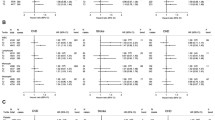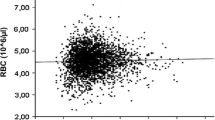Abstract
White blood cell (WBC) count is associated with incident coronary heart disease (CHD). Data are sparse regarding its association in young adults with future coronary artery calcification (CAC). Our study was conducted among coronary artery risk development in young adults (CARDIA) participants (n = 3,094). We examined the association between baseline (Y0) WBC counts and CHD risk factors using linear regression models. We further assessed prospective associations between Y0 WBC and inflammatory biomarkers during the follow-up, and the presence of CAC 15 and 20 years later. In total, 272 and 566 subjects had CAC scores >0 at year (Y) 15 and Y20, respectively. Baseline total WBC counts were cross-sectionally associated with SBP, BMI, and smoking, or HDL-cholesterol (p ≤ 0.01) at Y0, and prospectively associated with C-reactive protein at Y7, Y15, and Y20, and fibrinogen at Y5 and Y20 (p < 0.01). After adjustment for potential confounding factors, baseline neutrophil count was borderline associated with CAC presence 15 years later (OR = 1.18 per unit, 95 % CI 1.00–1.44) and total WBC (OR = 1.07, 95 % CI 0.96–1.19) or eosinophil (OR = 1.12, 95 %CI 1.00–1.25) was borderline associated with CAC presence at Y20. Baseline total WBC counts in young adults was associated prospectively with CAC presence 20 years later after adjusting for age, sex, and race. Results are attenuated when other risk factors are accounted for. Our results suggest the possible early involvement of WBC, particularly eosinophils, in the early stages of atherosclerosis.
Similar content being viewed by others
References
Roger VL, Go AS, Lloyd-Jones DM, Benjamin EJ, Berry JD, Borden WB, et al. Heart disease and stroke statistics–2012 update: a report from the American Heart Association. Circulation. 2012;125(1):e2–220. doi:CIR.0b013e31823ac046.
Lloyd-Jones DM. Short-term versus long-term risk for coronary artery disease: implications for lipid guidelines. Curr Opin Lipidol. 2006;17(6):619–25. doi:10.1097/MOL.0b013e3280108740.
Mahoney LT, Burns TL, Stanford W, Thompson BH, Witt JD, Rost CA, et al. Coronary risk factors measured in childhood and young adult life are associated with coronary artery calcification in young adults: the Muscatine Study. J Am Coll Cardiol. 1996;27(2):277–84. doi:0735-1097(95)00461-0.
Klag MJ, Ford DE, Mead LA, He J, Whelton PK, Liang KY, et al. Serum cholesterol in young men and subsequent cardiovascular disease. N Engl J Med. 1993;328(5):313–8. doi:10.1056/NEJM199302043280504.
Loria CM, Liu K, Lewis CE, Hulley SB, Sidney S, Schreiner PJ, et al. Early adult risk factor levels and subsequent coronary artery calcification: the CARDIA Study. J Am Coll Cardiol. 2007;49(20):2013–20. doi:S0735-1097(07)00832-7.
Libby P, Ridker PM, Maseri A. Inflammation and atherosclerosis. Circulation. 2002;105(9):1135–43.
Ross R. Atherosclerosis–an inflammatory disease. N Engl J Med. 1999;340(2):115–26. doi:10.1056/NEJM199901143400207.
Prentice RL, Szatrowski TP, Fujikura T, Kato H, Mason MW, Hamilton HH. Leukocyte counts and coronary heart disease in a Japanese cohort. Am J Epidemiol. 1982;116(3):496–509.
Sen S, Hinderliter A, Sen PK, Simmons J, LeGrys VA, Beck J, et al. Association of leukocyte count with progression of aortic atheroma in stroke/transient ischemic attack patients. Stroke. 2007;38(11):2900–5. doi:STROKEAHA.107.489658.
Madjid M, Awan I, Willerson JT, Casscells SW. Leukocyte count and coronary heart disease: implications for risk assessment. J Am Coll Cardiol. 2004;44(10):1945–56. doi:S0735-1097(04)01707-3.
Giugliano G, Brevetti G, Lanero S, Schiano V, Laurenzano E, Chiariello M. Leukocyte count in peripheral arterial disease: a simple, reliable, inexpensive approach to cardiovascular risk prediction. Atherosclerosis. 2010;210(1):288–93.
Margolis KL, Manson JE, Greenland P, Rodabough RJ, Bray PF, Safford M, et al. Leukocyte count as a predictor of cardiovascular events and mortality in postmenopausal women: the Women’s Health Initiative Observational Study. Arch Intern Med. 2005;165(5):500–8. doi:165/5/500.
Sweetnam PM, Thomas HF, Yarnell JW, Baker IA, Elwood PC. Total and differential leukocyte counts as predictors of ischemic heart disease: the Caerphilly and Speedwell studies. Am J Epidemiol. 1997;145(5):416–21.
Huang ZS, Chien KL, Yang CY, Wang CH, Chang TC, Chen CJ. Peripheral differential leukocyte counts and subsequent mortality from all diseases, cancers, and cardiovascular diseases in Taiwanese. J Formos Med Assoc. 2003;102(11):775–81.
Kawaguchi H, Mori T, Kawano T, Kono S, Sasaki J, Arakawa K. Band neutrophil count and the presence and severity of coronary atherosclerosis. Am Heart J. 1996;132(1 Pt 1):9–12.
Olivares R, Ducimetiere P, Claude JR. Monocyte count: a risk factor for coronary heart disease? Am J Epidemiol. 1993;137(1):49–53.
O’Malley PG, Taylor AJ, Jackson JL, Doherty TM, Detrano RC. Prognostic value of coronary electron-beam computed tomography for coronary heart disease events in asymptomatic populations. Am J Cardiol. 2000;85(8):945–8. doi:S0002-9149(99)00906-6.
Sangiorgi G, Rumberger JA, Severson A, Edwards WD, Gregoire J, Fitzpatrick LA, et al. Arterial calcification and not lumen stenosis is highly correlated with atherosclerotic plaque burden in humans: a histologic study of 723 coronary artery segments using nondecalcifying methodology. J Am Coll Cardiol. 1998;31(1):126–33. doi:S0735-1097(97)00443-9.
Arad Y, Spadaro LA, Goodman K, Lledo-Perez A, Sherman S, Lerner G, et al. Predictive value of electron beam computed tomography of the coronary arteries. 19-month follow-up of 1,173 asymptomatic subjects. Circulation. 1996;93(11):1951–3.
Berry JD, Liu K, Folsom AR, Lewis CE, Carr JJ, Polak JF, et al. Prevalence and progression of subclinical atherosclerosis in younger adults with low short-term but high lifetime estimated risk for cardiovascular disease: the coronary artery risk development in young adults study and multi-ethnic study of atherosclerosis. Circulation. 2009;119(3):382–9. doi:CIRCULATIONAHA.108.800235.
Friedman GD, Cutter GR, Donahue RP, Hughes GH, Hulley SB, Jacobs DR Jr, et al. CARDIA: study design, recruitment, and some characteristics of the examined subjects. J Clin Epidemiol. 1988;41(11):1105–16. doi:0895-4356(88)90080-7.
Iribarren C, Sidney S, Bild DE, Liu K, Markovitz JH, Roseman JM, et al. Association of hostility with coronary artery calcification in young adults: the CARDIA study. Coronary Artery Risk Development in Young Adults. JAMA. 2000;283(19):2546–51.
Kaufmann RB, Sheedy PF 2nd, Breen JF, Kelzenberg JR, Kruger BL, Schwartz RS, et al. Detection of heart calcification with electron beam CT: interobserver and intraobserver reliability for scoring quantification. Radiology. 1994;190(2):347–52.
Bielak LF, Kaufmann RB, Moll PP, McCollough CH, Schwartz RS, Sheedy PF 2nd. Small lesions in the heart identified at electron beam CT: calcification or noise? Radiology. 1994;192(3):631–6.
Agatston AS, Janowitz WR, Hildner FJ, Zusmer NR, Viamonte M Jr, Detrano R. Quantification of coronary artery calcium using ultrafast computed tomography. J Am Coll Cardiol. 1990;15(4):827–32. doi:0735-1097(90)90282-T.
Libby P, Theroux P. Pathophysiology of coronary artery disease. Circulation. 2005;111(25):3481–8. doi:111/25/3481.
Asthana A, Johnson HM, Piper ME, Fiore MC, Baker TB, Stein JH. Effects of smoking intensity and cessation on inflammatory markers in a large cohort of active smokers. Am Heart J. 2010;160(3):458–63.
Yasue H, Hirai N, Mizuno Y, Harada E, Itoh T, Yoshimura M, et al. Low-grade inflammation, thrombogenicity, and atherogenic lipid profile in cigarette smokers. Circ J. 2006;70(1):8–13.
Laurson KR, McCann DA, Senchina DS. Age, sex, and ethnicity may modify the influence of obesity on inflammation. J Investig Med. 2011;59(1):27–31. doi:10.231/JIM.0b013e318200151a.
Ohshita K, Yamane K, Hanafusa M, Mori H, Mito K, Okubo M, et al. Elevated white blood cell count in subjects with impaired glucose tolerance. Diabetes Care. 2004;27(2):491–6.
Alexander RW. Theodore cooper memorial lecture. Hypertension and the pathogenesis of atherosclerosis. Oxidative stress and the mediation of arterial inflammatory response: a new perspective. Hypertension. 1995;25(2):155–61.
Ritchie SA, Connell JM. The link between abdominal obesity, metabolic syndrome and cardiovascular disease. Nutr Metab Cardiovasc Dis. 2007;17(4):319–26. doi:S0939-4753(06)00150-5.
Pauletto P, Rattazzi M. Inflammation and hypertension: the search for a link. Nephrol Dial Transplant. 2006;21(4):850–3. doi:gfl019.
Libby P. Inflammation in atherosclerosis. Nature. 2002;420(6917):868–74. doi:10.1038/nature01323.
Bovill EG, Bild DE, Heiss G, Kuller LH, Lee MH, Rock R, et al. White blood cell counts in persons aged 65 years or more from the Cardiovascular Health Study. Correlations with baseline clinical and demographic characteristics. Am J Epidemiol. 1996;143(11):1107–15.
Ogawa Y, Imaki M, Yoshida Y, Shibakawa M, Tanada S. An epidemiological study on the association between the total leukocyte and neutrophil counts, and risk factors of ischemic heart disease by smoking status in Japanese factory workers. Appl Human Sci. 1998;17(6):239–47.
Ford ES, Galuska DA, Gillespie C, Will JC, Giles WH, Dietz WH. C-reactive protein and body mass index in children: findings from the Third National Health and Nutrition Examination Survey, 1988–1994. J Pediatr. 2001;138(4):486–92. doi:S0022-3476(01)30378-5.
Capuano V, Lamaida N, De Martino M, Mazzotta G. Association between white blood cell count and risk factors of coronary artery disease. G Ital Cardiol. 1995;25(9):1145–52.
Sattar N, McCarey DW, Capell H, McInnes IB. Explaining how “high-grade” systemic inflammation accelerates vascular risk in rheumatoid arthritis. Circulation. 2003;108(24):2957–63. doi:10.1161/01.CIR.0000099844.31524.05108/24/2957.
Pearson TA, Mensah GA, Alexander RW, Anderson JL, Cannon RO 3rd, Criqui M, et al. Markers of inflammation and cardiovascular disease: application to clinical and public health practice: a statement for healthcare professionals from the Centers for Disease Control and Prevention and the American Heart Association. Circulation. 2003;107(3):499–511.
Schratzberger P, Dunzendorfer S, Reinisch N, Kahler CM, Herold M, Wiedermann CJ. Release of chemoattractants for human monocytes from endothelial cells by interaction with neutrophils. Cardiovasc Res. 1998;38(2):516–21. doi:S0008-6363(98)00014-5.
Blann AD, Seigneur M, Adams RA, McCollum CN. Neutrophil elastase, von Willebrand factor, soluble thrombomodulin and percutaneous oxygen in peripheral atherosclerosis. Eur J Vasc Endovasc Surg. 1996;12(2):218–22.
Mohacsi A, Fulop T Jr, Kozlovszky B, Hauck M, Kiss I, Leovey A. Sera and leukocyte elastase-type protease and antiprotease activity in healthy and atherosclerotic subjects of various ages. J Gerontol. 1992;47(5):B154–8.
Lee CD, Folsom AR, Nieto FJ, Chambless LE, Shahar E, Wolfe DA. White blood cell count and incidence of coronary heart disease and ischemic stroke and mortality from cardiovascular disease in African-American and White men and women: atherosclerosis risk in communities study. Am J Epidemiol. 2001;154(8):758–64.
Marone G. Asthma: recent advances. Immunol Today. 1998;19(1):5–9. doi:S0167569997011870.
Chihara J, Yamamoto T, Kurachi D, Kakazu T, Higashimoto I, Nakajima S. Possible release of eosinophil granule proteins in response to signaling from intercellular adhesion molecule-1 and its ligands. Int Arch Allergy Immunol. 1995;108(Suppl 1):52–4.
Hernnas J, Sarnstrand B, Lindroth P, Peterson CG, Venge P, Malmstrom A. Eosinophil cationic protein alters proteoglycan metabolism in human lung fibroblast cultures. Eur J Cell Biol. 1992;59(2):352–63.
Niccoli G, Ferrante G, Cosentino N, Conte M, Belloni F, Marino M, et al. Eosinophil cationic protein: a new biomarker of coronary atherosclerosis. Atherosclerosis. 2010;211(2):606–11.
Emanuele E, Falcone C, D’Angelo A, Minoretti P, Buzzi MP, Bertona M, et al. Association of plasma eotaxin levels with the presence and extent of angiographic coronary artery disease. Atherosclerosis. 2006;186(1):140–5.
Haley KJ, Lilly CM, Yang JH, Feng Y, Kennedy SP, Turi TG, et al. Overexpression of eotaxin and the CCR3 receptor in human atherosclerosis: using genomic technology to identify a potential novel pathway of vascular inflammation. Circulation. 2000;102(18):2185–9.
Sigal E, Sloane DL, Conrad DJ. Human 15-lipoxygenase: induction by interleukin-4 and insights into positional specificity. J Lipid Mediat. 1993;6(1–3):75–88.
Acknowledgments
The Coronary artery risk development in young adults study (CARDIA) is conducted and supported by the National Heart, Lung, and Blood Institute (NHLBI) in collaboration with the University of Alabama at Birmingham (N01-HC95095 & N01-HC48047), University of Minnesota (N01-HC48048), Northwestern University (N01-HC48049), and Kaiser Foundation Research Institute (N01-HC48050). This manuscript has been reviewed by CARDIA for scientific content and consistency of data interpretation with previous CARDIA publications.
Conflict of interest
None.
Author information
Authors and Affiliations
Corresponding author
Electronic supplementary material
Below is the link to the electronic supplementary material.
Rights and permissions
About this article
Cite this article
Hou, L., Lloyd-Jones, D.M., Ning, H. et al. White blood cell count in young adulthood and coronary artery calcification in early middle age: coronary artery risk development in young adults (CARDIA) study. Eur J Epidemiol 28, 735–742 (2013). https://doi.org/10.1007/s10654-013-9842-7
Received:
Accepted:
Published:
Issue Date:
DOI: https://doi.org/10.1007/s10654-013-9842-7




